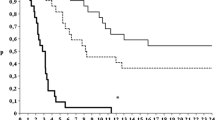Abstract
Introduction
Ropivacaine belongs to pipecoloxylidide group of local anesthetics. There are reports supporting the use of ropivacaine as a long acting local anesthetic in oral and maxillofacial surgical procedures, with variable data on the concentration that is clinically suitable.
Materials and Methods
A prospective randomized double-blind study protocol was undertaken to assess the efficacy of 0.5 and 0.75 % ropivacaine for inferior alveolar nerve block in surgical extraction of impacted mandibular third molars. A total of 60 procedures were performed, of which thirty patients received 0.5 % and thirty received 0.75 % concentration of the study drug.
Results
All the patients in both the study groups reported subjective numbness of lip and tongue. The time of onset was longer for 0.5 % ropivacaine when compared to 0.75 % solution. 90 % of the study patients in 0.5 % ropivacaine group reported pain corresponding to VAS ≥3 during bone guttering and 93.3 % patients reported pain corresponding to VAS >4 during tooth elevation. None of the patients in 0.75 % ropivacaine group reported VAS >3 at any stage of the surgical procedure. The duration of soft tissue anesthesia recorded with 0.75 % ropivacaine was average 287.57 ± 42.0 min.
Conclusion
0.75 % ropivacaine was found suitable for inferior alveolar nerve blocks in surgical extraction of impacted mandibular third molars.



Similar content being viewed by others
References
All-Atabakhsh A, Rosenberg MB (2012) Ropivacaine: the next dental local anesthetic? J Mass Dent Soc 61:14–16
McClure JH (1996) Ropivacaine. Br J Anaesth 76:300–307
McClellan KJ, Faulds D (2000) Ropivacaine: an update of its use in regional anaesthesia. Drugs 60:1065–1093
Ernberg M, Kopp S (2002) Ropivacaine for dental anesthesia: a dose-finding study. J Oral Maxillofac Surg 60:1004–1010
Axelsson S, Isacsson G (2004) The efficacy of ropivacaine as a dental local anaesthetic. Swed Dent J 28:85–91
El-Sharrawy E, Yagiela JA (2006) Anesthetic efficacy of different ropivacaine concentrations for inferior alveolar nerve block. Anesth Prog 53:3–7
Malamed SF (2004) Handbook of local anesthesia, Mosby, St. Louis, 5th edn
Kirkman TW (1996) Statistics to use. http://www.physics.csbsju.edu/stats/ Accessed 26 July 2012
Brkovic BM, Zlatkovic M, Jovanovic D, Stojic D (2010) Maxillary infiltration anaesthesia by ropivacaine for upper third molar surgery. Int J Oral Maxillofac Surg 39:36–41
Author information
Authors and Affiliations
Corresponding author
Rights and permissions
About this article
Cite this article
Bhargava, D., Chakravorty, N., Rethish, E. et al. Comparative Analysis of the Anesthetic Efficacy of 0.5 and 0.75 % Ropivacaine for Inferior Alveolar Nerve Block in Surgical Removal of Impacted Mandibular Third Molars. J. Maxillofac. Oral Surg. 13, 431–434 (2014). https://doi.org/10.1007/s12663-013-0534-3
Received:
Accepted:
Published:
Issue Date:
DOI: https://doi.org/10.1007/s12663-013-0534-3




